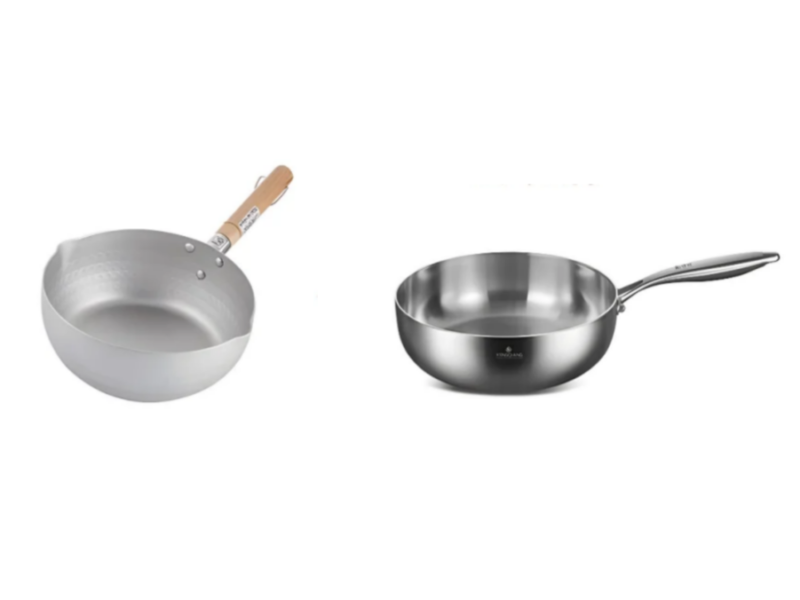
As a professional stainless steel cookware manufacturer, we are often asked by customers: How to choose between aluminum cookware and stainless steel cookware? Both types of cookware are very popular in the market, and each has its own unique advantages and disadvantages. I will introduce the differences between the two to you based on our professional knowledge.
Is Stainless Steel Aluminum
Since stainless steel cookware and aluminum cookware have a certain similarity in appearance, some users may think that stainless steel is aluminum, but stainless steel and aluminum are two completely different metals. Stainless steel is an alloy composed of iron, chromium and nickel, while aluminum is a metal composed of aluminum elements. There are obvious differences between the two in chemical composition, physical properties and uses. Pay attention to the difference when purchasing cookware.
What is Stainless Steel Cookware?
The main components of stainless steel cookware are iron, chromium and nickel, which are key factors in ensuring its performance and durability. Iron is the base material, providing structural strength and toughness, allowing the cookware to withstand high temperatures and the pressure of daily use. Chromium gives stainless steel its “rust-resistant” properties, usually at a minimum of 10.5%, forming a solid protective layer of chromium oxide that effectively prevents oxidation and corrosion, while nickel improves corrosion resistance and high temperature resistance, while enhancing gloss and resistance to deformation. These ingredients make stainless steel cookware durable, heat-resistant, and easy to clean.
304 stainless steel is the most commonly used material for kitchen cookware. 304 stainless steel contains about 18% chromium and 8% nickel, so it is also called 18/8 stainless steel. 316 stainless steel is another high-grade stainless steel material, which is often used in high-end products such as professional cookware. 316 stainless steel contains about 16% chromium, 10% nickel and 2% molybdenum, which makes it have a longer service life and better corrosion resistance than 304 stainless steel.
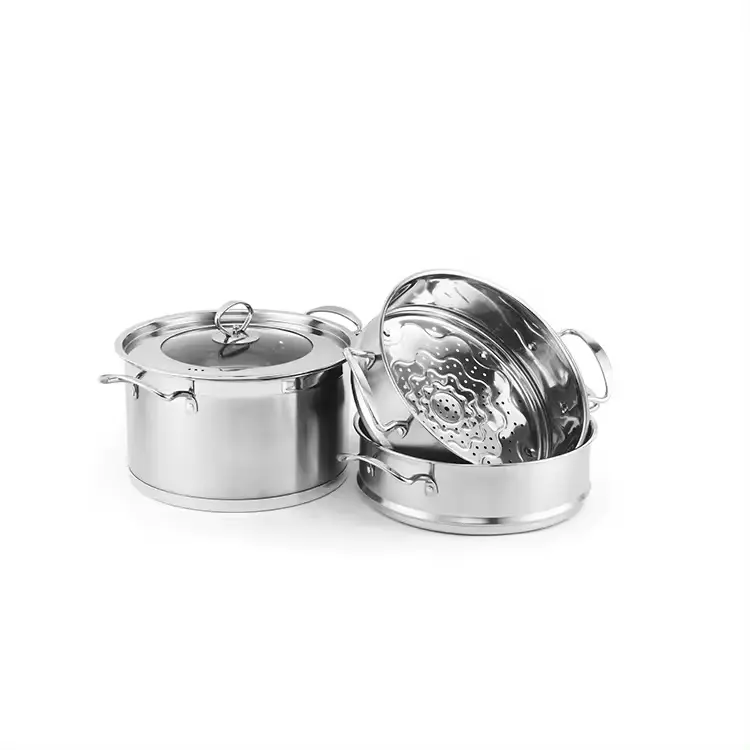

Advantages Of Stainless Steel Cookware
Healthy material: Most well-known brand manufacturers use food-grade stainless steel. High-quality stainless steel itself is resistant to acid, salt, corrosion, and high temperature. It will not precipitate heavy metals and other harmful substances after long-term use.
Strong and durable: Stainless steel materials are very strong and can resist scratches and impacts. This durability allows stainless steel cookware to maintain good appearance and performance during long-term use, has a longer service life, and reduces the frequency of replacement.
Easy to clean: Compared with other types of pots, stainless steel pots are relatively easy to clean. They can usually be easily cleaned with neutral detergent and warm water, and are not easily scratched or damaged.
Even heating: Most stainless steel pots will add a triply stainless steel base to the bottom, which can provide uniform heating distribution when in use to avoid partial burning of food. This is very important for cooking tasks that require precise temperature control.
Good-looking appearance: Different from other black pots, the glossy texture of the brushed metal itself makes it very eye-catching in the kitchen, adding a sense of luxury to the kitchen.
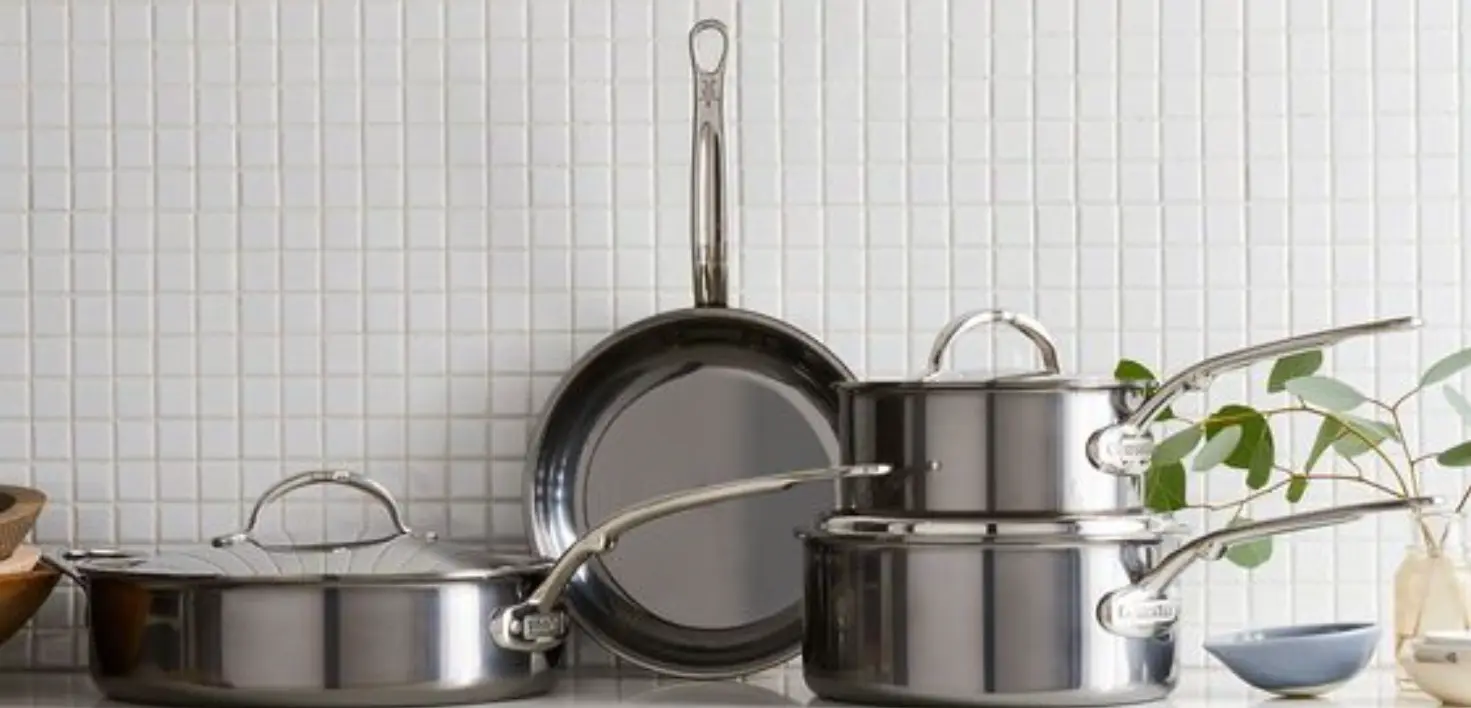
Disadvantages of stainless steel cookware
Hotspot phenomenon: Stainless steel itself does not conduct heat as well as aluminum or copper, which may cause uneven heat distribution and cause hot spots. To improve this, many stainless steel cookware will add an aluminum or copper layer to the bottom, but this also increases the cost.
Heavier: Stainless steel cookware is usually heavier, especially with thick bottoms or thick walls. This may make it less convenient to use or move than lighter materials such as aluminum cookware.
Possible discoloration: Stainless steel cookware may discolor or fade when exposed to high temperatures or in contact with certain foods. Although this does not affect its performance, it may affect its appearance.
Higher price: High-quality stainless steel cookware is relatively expensive, especially 316 stainless steel. Due to the complex process and high raw material prices, stainless steel cookware is relatively expensive compared to other types of cookware, which may affect the choice of consumers with limited budgets.
What is Aluminum Cookware?
Aluminum metal forms the main part of aluminum cookware with elements like silicon, copper, magnesium, or manganese commonly added to increase their resistance against corrosion and make them last longer in the kitchen.
In addition, many aluminum cookware surfaces are anodized, an electrochemical process that forms a hard aluminum oxide layer on the aluminum surface, increasing its corrosion and wear resistance.
In fact every hard anodized cookware is made of aluminum; however not all aluminum cookware is hard anodized. Hard anodized cookware can thus be defined as a type of premium-quality aluminum Cookware which undergoes an additional process known as anodizing, this makes it more durable and enhances its performance.
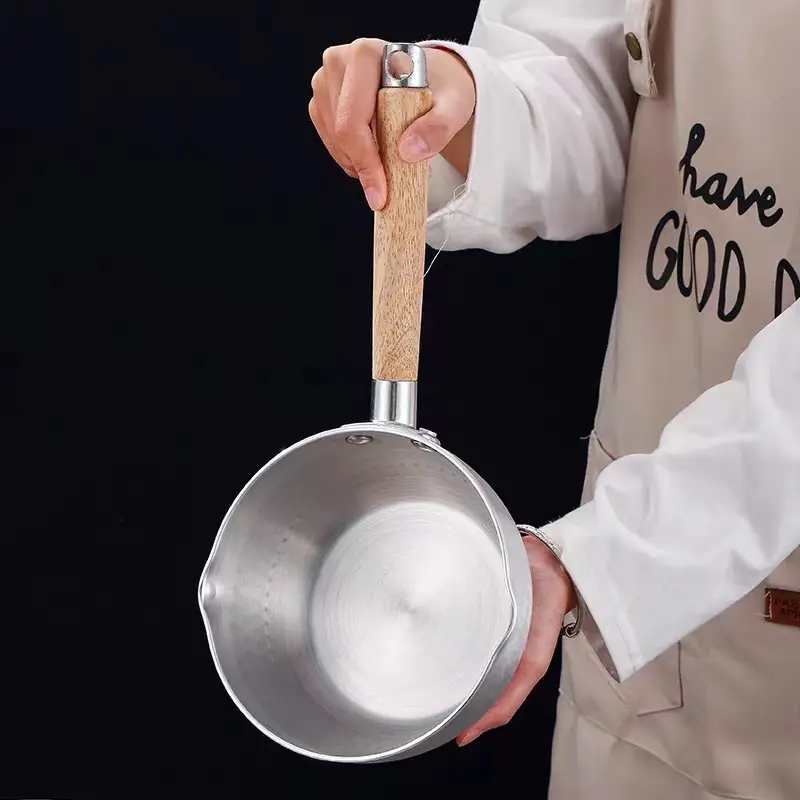
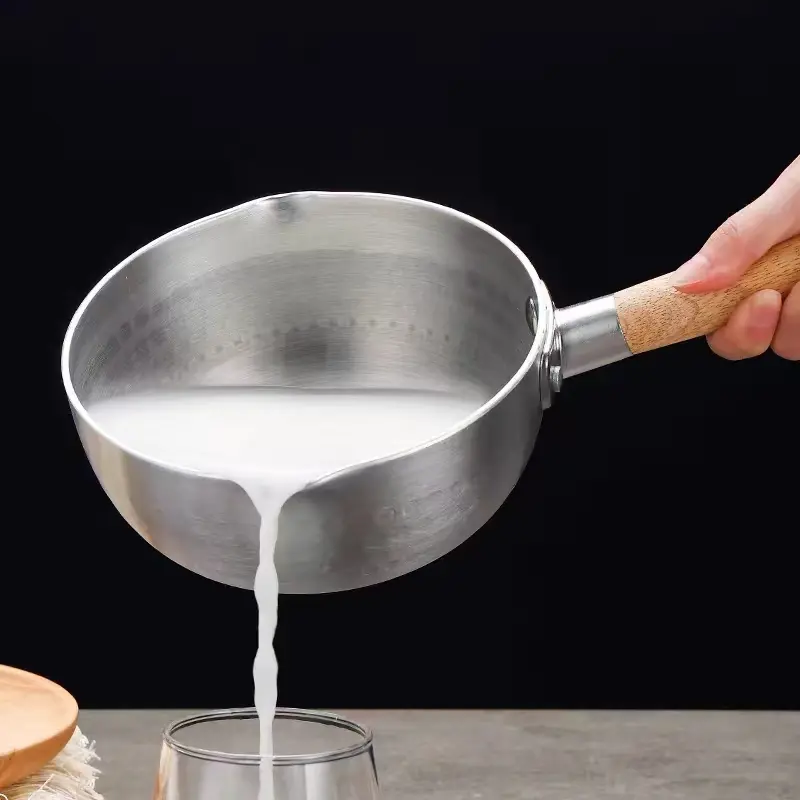
Advantages of Aluminum Cookware
Lightweight: Aluminum cookware is thus actually very convenient to use and move primarily because of the light weight of the aluminum itself. As a result, it is easier to handle when compared with other cookware metals made from materials that are heavier in comparison.
Advantages of Aluminum Cookware
Corrosion Resistance: Anodized aluminum cookware has good corrosion resistance. This treatment process can form a hard oxide layer on the surface of aluminum, which improves its durability and reduces reaction with acidic or salty foods.
Excellent thermal conductivity: Thermal conductivity of aluminum is exceptional; it can transfer heat rapidly and uniformly. Therefore, during cooking it helps to attain more uniform cooking results as aluminum cookery heats up rapidly making it easier for the food items being prepared in them to be uniformly cooked.
Fast heating: Aluminum has high heat transfer efficiency, allowing the cookware to quickly reach the required cooking temperature, saving cooking time.
Economical: Aluminum cookware is generally more economical than many other cookware materials, and its price is relatively affordable, suitable for consumers with limited budgets.
Disadvantages of Aluminum Cookware
Low Durability:There is no way for you to deny that raw aluminum cookware is prone to scratches and dents even if they are capable of being anodized for increased resistance. In contrast, it lacks a significant level of overall durability when compared with such materials as stainless steel.
Reactivity:Usually, one cannot keep pre-pickled edibles or other acidic/alkaline ones in standard aluminum vessels. If you use such vessels for dishes having high levels of acidity or alkalinity, you will taste something different from what you prepared and aluminum ions might also go into your food through these vessels.Although anodized aluminum cookware can reduce this reaction, untreated aluminum cookware still has this problem.
Cannot cook at high temperatures:Aluminum cookware is not suitable for high-temperature cooking, because high temperatures may cause aluminum deformation and the service life of aluminum cookware may be affected. In addition, under high temperature conditions, aluminum components may be released. Long-term excessive aluminum consumption will harm human health.
Discoloration:Aluminum cookware may discolor over time, especially when exposed to high temperatures or in contact with certain foods, which may affect its appearance.
Aluminum Cookware Vs Stainless Steel Cookware
Is stainless steel or aluminum better?
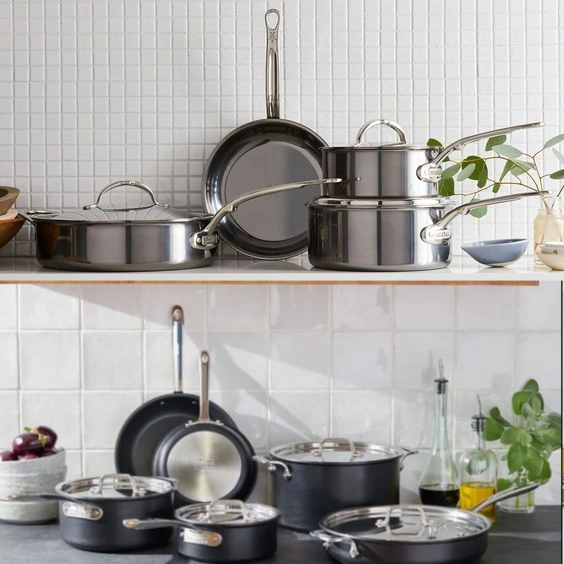
Aluminum Cookware vs. Stainless Steel Cookware: Health and Safety Comparison
When it comes to health safety, stainless steel cookware is safer than aluminum cookware. Untreated aluminum cookware may release aluminum, especially when cooking acidic foods, which may have adverse effects on health. Another important but less known conclusion is that high-protein foods such as meat, milk, and beans should not be cooked in aluminum pots because both animal and plant proteins are more likely to combine with aluminum, and aluminum in the form of aluminum hydroxide may cause greater damage to health.
In contrast, stainless steel cookware is considered safer because it does not react with food. In addition, high-quality stainless steel cookware is made of food-grade materials to ensure long-term safety.
In fact, there are many restrictions on cooking with aluminum pots, and there is a risk of aluminum dissolution. Therefore, from the perspective of safety and health, stainless steel cookware is a better choice.
Aluminum vs. Stainless Steel Cookware: A Comparison of Thermal Conductivity
Compared to Aluminum Cookware, stainless steel pots and pans do not conduct heat very well. As a result, they often have to be fitted with an layer made of aluminum or copper so that the heat can be distributed evenly over its entire surface. Although their thermal conductivity are lower than those of aluminum, it is still possible for such utensils to hold heat for many hours and are thus more suitable for dishes requiring prolonged cooking processes such as slow-cooked stews.
Aluminum Cookware vs. Stainless Steel Cookware: A Comparison of Suitability
Stainless steel cookware is better than aluminum cookware in corrosion resistance, chemical stability, durability and heat resistance. Stainless steel’s good corrosion resistance and chemical stability make it suitable for cooking all kinds of food. High-quality stainless steel cookware can remain stable in acidic, alkaline or high temperature environments. Aluminum cookware has the risk of aluminum dissolving in acidic, alkaline or high temperature. From the perspective of the types of food to be cooked, stainless steel cookware obviously has more choices, while aluminum cookware should try to avoid foods with too high acidity and alkalinity and avoid too high temperatures.
From the perspective of durability, stainless steel is one of the best cookware materials. Its sturdy properties make it resistant to falling and scratching, and it is very suitable even for carrying out. Ordinary aluminum cookware is easy to dent and scratch, and is not often used as a cooking tool for camping.
Is Aluminum Or Stainless Steel Better For Cooking?
When it comes to cooking, stainless steel and aluminum cookware have their own advantages and disadvantages. It is best to choose according to the food or method of cooking. Aluminum cookware has excellent thermal conductivity and is a better choice for foods that need to be cooked in a short time, such as stir-fry or pancakes.
Stainless steel cookware is more suitable for dishes that require long cooking time or high temperature requirements. For example, processes such as stewing, braising, and cooking sauces require stable and long-lasting heating.

How To Tell Aluminum From Stainless Steel Cookware?
Appearance and Weight
Stainless steel is usually silvery white, with a smooth and shiny surface and is generally heavy. Aluminum cookware may have a matte silver-gray surface, and may sometimes be anodized or coated to give it a different color or texture. However, aluminum cookware is usually lightweight and feels more comfortable to hold, so it is easy to distinguish between stainless steel and aluminum pots by the feel when lifting them.
Sound Test
When stainless steel cookware is knocked, it will make a crisp sound, while aluminum cookware will usually make a dull and low sound when knocked.
Marking and Labeling
Stainless steel cookware: It is usually marked with the words “Stainless Steel” on the bottom or side, and sometimes the type of stainless steel, such as 18/10 or 304.
Aluminum cookware: The label may say “Aluminum” or “Alum”, or simply “Aluminum Cookware”.
Price
Stainless steel cookware: Usually more expensive than aluminum cookware, especially high-quality stainless steel cookware.
Conclusion
As a professional kitchenware manufacturer, I recommend you to choose stainless steel cookware, which performs better in durability, heat resistance and corrosion resistance. Although its thermal conductivity is worse than that of aluminum cookware, most stainless steel cookware on the market currently has aluminum and copper layers added to its bottom, so the thermal conductivity of stainless steel cookware is still very good. Compared with aluminum cookware, stainless steel cookware can cope with a wider variety of foods. Due to its chemical stability, it will not produce harmful substances in high temperature, acid and alkaline environments, and is the first choice for many professional kitchens.
In terms of price, aluminum cookware is usually more economical than stainless steel cookware, which makes aluminum cookware very popular in the entry-level market. However, in the long-term use, due to the stronger durability and lower maintenance costs of stainless steel cookware, buying stainless steel cookware is a more cost-effective investment.
About Hengguang Kitchenware Manufacturer
Hengguang is a stainless steel kitchenware manufacturer from China with over 30 years of OEM & ODM manufacturing experience. We are one of the first experienced stainless steel cookware suppliers and wholesalers in China. We provide wholesale kitchenware and customized kitchenware solutions, and have provided OEM services to more than 80 well-known brands around the world. Our wholesale kitchenware includes cookware sets, pressure cookers, mini pressure cookers, stainless steel lunch boxes. Welcome to contact us for a tailor-made solution.